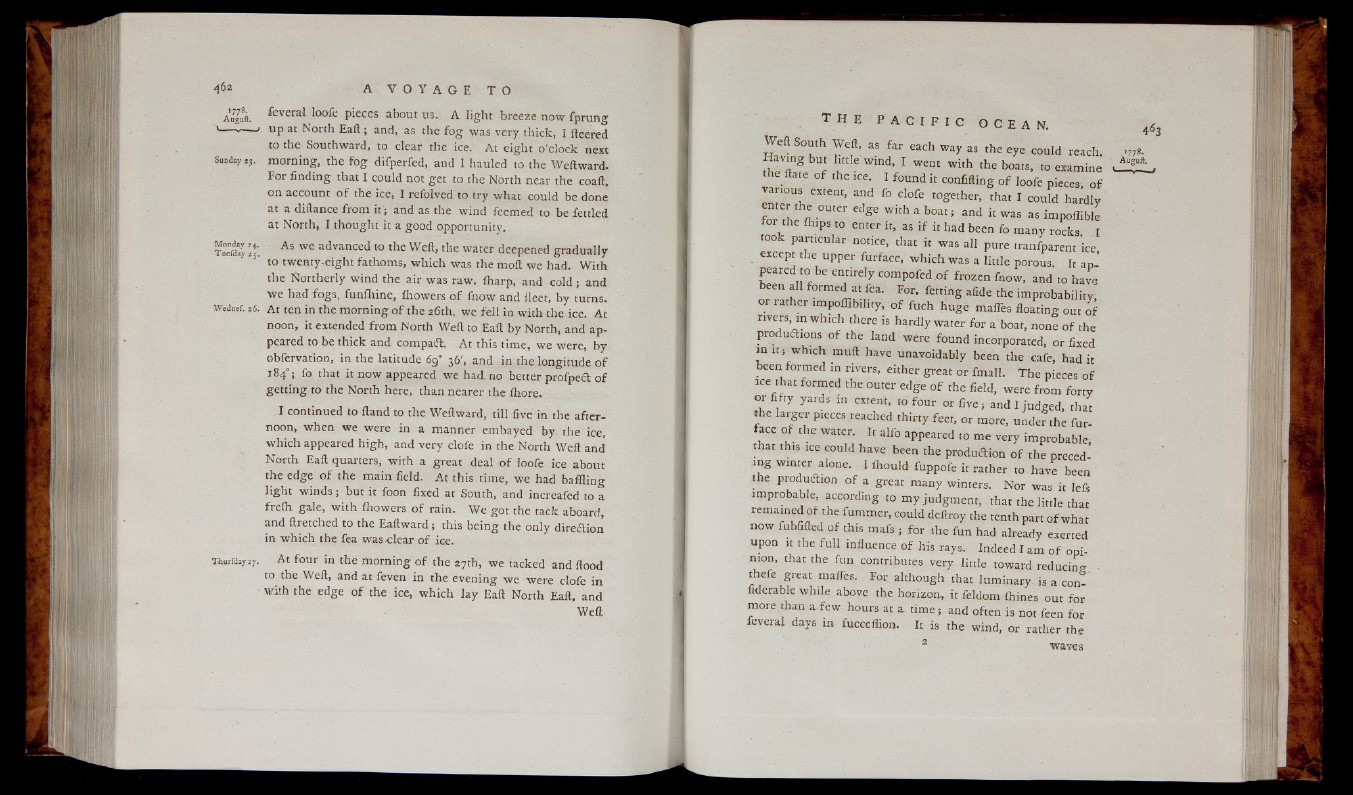
Augui. feveral loofe pieces about us. A light breeze now fprung
>---- -— j up at North Eaft ; and, as the fo g was very thick, I fleered
to the Southward, to clear the ice. At eight o ’clock next
Sunday z3. morning, the fo g difperfed, and I hauled to the Weftward-
f o r finding that I could not g e t to the North near the coaft,
on account o f the ice, I refolved to try what could be done
at a difiance from i t ; and as the wind feemed to be fettled
at North, I thought it a good opportunity.
Tuefiiay £ As we advanced “ the Weft, the water deepened grad ually
to twenty-eight fathoms, which was the mod we had. With
the Northerly wind the air was raw, iharp, and c o ld ; and
we had fogs, funihine, Ihowers o f fnow and fleet, by turns.
Wcdnef. 26. At ten in the morning o f the 26th, we fe ll in with the ice. At
noon, it extended from North Weft to Eaft by North, and appeared
to be thick and compaffc. A t this time, we were, by
obiervation, in the latitude 6q 36*» and in the longitude o f
184°; fo that it now appeared we had.no better profpecb o f
g e ttin g to the North here, than nearer the ihore.
I continued to ftand to the Weftward, till five in the afternoon,
when we were in a manner embayed b y the ice,
which appeared high, and v e ry clofe in the North Weft and
North Eaft quarters, w ith a great deal o f loofe ice about
the edge o f the main field. A t this time, we had bafHing
ligh t w in d s ; but it foon fixed at South, and increafed to a
freih gale, w ith iliowers o f rain. We got the tack aboard,
and ftretched to the Eaftward; this be in g the only direction
in w hich the fea was c le a r o f ice.
TAurfdayz?. A t four in the morning o f the 27th, we tacked and flood
to the Weft, and at feven in the evening we were clofe in
with the edge o f the ice, w hich la y Eaft North Eaft, and
Weft
. t h e P A C I F I C O C E AN.
Weft South Weft, as far each w ay as the eye could reach.
Having but httle wind, I went with the boats, to examine
he ftate o f the ice. I found it confifting o f loofe pieces, o f
™ h f tent’ f° Cl° fe t0gether> that 1 could ha^
for the fh .°Uter edge Wlth a b o a t> and it was as impoffible
for the ihips to enter it, as i f it had been fo many rocks I
took particular notice, that it was all pure tranfparent ice
except the upper furface, which Was a little porous. It appeared
to be entirely compofed.of frozen fnow, and to have
been all formed at fea. For, fetting afide the improbability,
or rather impoffibility, o f fuch h u g e mafies floating out o f
rivers, in which there is hardly water for a boat, none o f the
productions o f the land were found incorporated, or fixed
m it ; which muffi have unavoidably been the cafe, had it
been formed m rivers, either great or fmall. T he pieces o f
ice that formed the outer edge o f the field, were from forty
or fifty yards in extent, to four or fiv e ; and I judged, that
the larger pieces reached thirty feet, or more, under the fur-
ace o f the water. It alfo appeared to me very improbable,
that this ice could have been the production o f the precedin
g winter alone. I fhould fuppofe it rather to have been
the production o f a great many winters. Nor was it lefs
improbable, according to my judgment, that the little that
remained o f the fummer, could deftroy the tenth part o f what
n ow fubfifted o f this mafs ; fo r the fun had already exerted
upon it the fu ll influence o f his rays. Indeed I am o f opinion,
that the fun contributes very little toward reducing
thefe great mafies. For although that luminary, is a con-
fiderable while above the horizon, it feldom ihines out for
more than a-few hours at a tim e; and often is not feen for
feveral days in fucceflion. It is the wind, or rather the
4^3
->778-
Auguft.